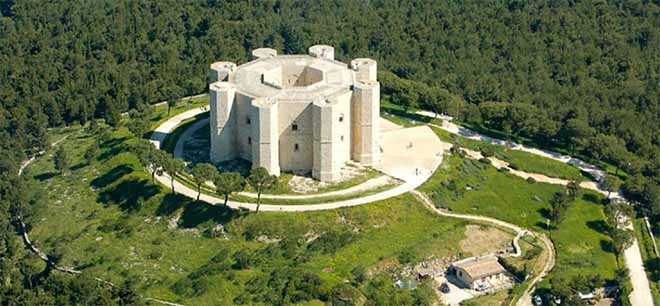Castel del Monte
The Holy Grail in Italy ?

Built at the top of a small hill 465 meters high and installed on the imaginary line that connects Jerusalem to Rome, Castel del Monte is one of the most enigmatic castles in the world. It was until then that the Holy Roman Empire extended in the 13th century, over which Frederick II of Swabia then reigned, well known under the name of Stupor mundi, “the wonder of people”. We are not sure of the date on which the castle of Castel del Monte was built, we suppose that it took place between 1230 and 1240, just as it is not specified what should have been its function. There were no moats or drawbridges, normally necessary for the defense of the castle against enemy attacks; nor were there rooms for garrisons, shops, kitchens and depots. Some speculate that Castel del Monte served as a hunting residence or a starting point for the sovereign for its battues, but there remains the pitfall of the excessive importance of the building. In any case, many agree that Frederick II had it built according to a very precise secret plan. Here, nothing seems to have been left to chance, starting with the choice of location.
The obsession with the number 8

Castel del Monte is located about halfway between Chartres Cathedral and the Great Pyramid of Giza, exactly on the axis that unites them: if we consider that it is the last of the three monuments to have been built, can it be just a coincidence? But that's not all: the plan of the Castel del Monte castle is octagonal; there are eight towers, also octagonal in shape. Their windows overlook an interior courtyard, still octagonal in shape, in the center of which was originally a basin which also had eight sides. On the outside portal and inside the different rooms are represented several species of flowers in groups of eight. The petals, in groups of eight, are also found on the capitals of the rooms and other details of the construction obsessively represent the number 8. We have still not found an explanation for this numerical recurrence.
A link between Castel del Monte and ancient Egypt ?
Frederick II of Swabia was fascinated by the East. Although he governed the Holy Roman Empire, he was excommunicated twice and he waged war against the papacy. His court - a rare example of magnificence - was frequented by poets, magicians and alchemists. In the esoteric tradition, the octagon was the figure uniting the earth to the sky. In the old baptisteries, whose plan was usually octagonal, this form was a tribute to the relationship between the newborn and God. But, there is yet another number which is recurrent and which seems to link Castel del Monte to ancient Egypt. The 111 (calculated in cubits, the unit of measurement of the Egyptians) appears as one of the key numbers of the Great Pyramid of Giza with the two terms of its sum 74 and 37 (the same numbers which often return in the Chartres Cathedral). The sum of the width of the six visible faces of each of the eight towers of Castel del Monte is equal to 37 Egyptian cubits and the sum of the length of the walls of the courtyard is equal to 111 Egyptian cubits. And Frederick II was not satisfied with using the numbers dear to the Egyptians, but he was inspired by their very method of construction. Indeed, on certain days, the shadows cast by the sun indicate very specific points. And there is also this: December 26, 1194 is the date of birth of Frederick II who lived until the age of 56; six facades for each of the eight octagonal towers, give 48 which, added to the eight outer perimeter walls, give 56, exactly the number of years that the emperor lived.
A mythical safe ?
Simple numbers games, perhaps. But some believe that the entire imposing construction would have been a huge safe erected to contain a legendary object: the Holy Grail. The entire Castel del Monte castle is said to represent the legendary lost chalice. On the verge of death, in 1250, Frederick II wanted to put on the robe of the Cistercian brothers, the same order that built the Chartres Cathedral and which inspired the Knights Templar. For some, this would be an indication proving that the holy relic passed, or that it is still hidden, in the impressive castle of Castel del Monte.









































































































































































































































































































































